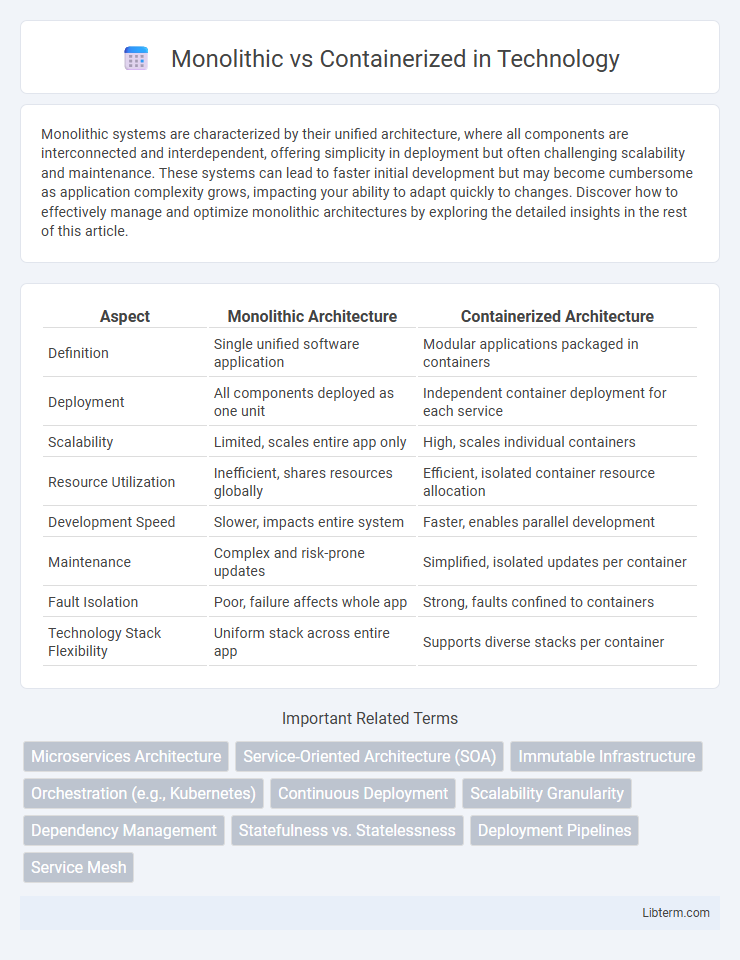Monolithic systems are characterized by their unified architecture, where all components are interconnected and interdependent, offering simplicity in deployment but often challenging scalability and maintenance. These systems can lead to faster initial development but may become cumbersome as application complexity grows, impacting your ability to adapt quickly to changes. Discover how to effectively manage and optimize monolithic architectures by exploring the detailed insights in the rest of this article.
Table of Comparison
| Aspect | Monolithic Architecture | Containerized Architecture |
|---|---|---|
| Definition | Single unified software application | Modular applications packaged in containers |
| Deployment | All components deployed as one unit | Independent container deployment for each service |
| Scalability | Limited, scales entire app only | High, scales individual containers |
| Resource Utilization | Inefficient, shares resources globally | Efficient, isolated container resource allocation |
| Development Speed | Slower, impacts entire system | Faster, enables parallel development |
| Maintenance | Complex and risk-prone updates | Simplified, isolated updates per container |
| Fault Isolation | Poor, failure affects whole app | Strong, faults confined to containers |
| Technology Stack Flexibility | Uniform stack across entire app | Supports diverse stacks per container |
Introduction to Monolithic and Containerized Architectures
Monolithic architecture is a traditional software design where all components are tightly integrated and operate as a single unit, making deployment straightforward but limiting scalability and flexibility. Containerized architecture breaks applications into smaller, independent services packaged with their dependencies, enhancing portability, scalability, and faster deployment cycles. Containerization leverages technologies like Docker and Kubernetes to isolate and manage microservices, enabling more efficient resource utilization and continuous integration/continuous deployment (CI/CD) workflows.
Core Principles of Monolithic Applications
Monolithic applications are built as a single unified codebase where all components such as the user interface, business logic, and data access layers are tightly integrated. This architecture emphasizes simplicity in deployment and development but can lead to challenges in scalability, flexibility, and maintenance as the application grows. Core principles include centralized management, unified data handling, and synchronous communication between modules, which contrasts with the distributed nature of containerized microservices.
Key Features of Containerized Applications
Containerized applications leverage lightweight, portable containers that encapsulate all dependencies, enabling consistent environments across development, testing, and production. They offer rapid scaling and efficient resource utilization by isolating services into independently deployable units. Built-in orchestration tools like Kubernetes facilitate automated management, load balancing, and seamless updates without downtime.
Pros and Cons of Monolithic Architecture
Monolithic architecture centralizes all components into a single codebase, which simplifies deployment and debugging while offering straightforward development for smaller applications. However, it suffers from scalability limitations, as updating or scaling one component requires redeploying the entire application, leading to potential downtime and slower release cycles. High interdependency in monolithic systems often results in reduced flexibility and challenges in adopting new technologies or frameworks.
Pros and Cons of Containerized Architecture
Containerized architecture offers scalability and flexibility by isolating applications in lightweight, portable containers that ensure consistent performance across different environments. This approach enhances resource efficiency and simplifies deployment, but it introduces complexity in orchestration and requires robust security measures to manage container vulnerabilities. Managing persistent data and networking within container ecosystems can be challenging, demanding advanced tools like Kubernetes for effective container lifecycle management.
Scalability: Monolithic vs Containerized Approaches
Monolithic architectures face scalability challenges due to their tightly integrated components, requiring scaling of the entire application even if only a specific function demands more resources. Containerized approaches enable granular scaling by isolating services into individual containers, allowing independent resource allocation and efficient load distribution. This flexibility significantly enhances scalability, supports microservices, and reduces overhead compared to monolithic systems.
Deployment and Maintenance Considerations
Monolithic applications require deploying a single, large codebase, which can lead to longer downtime during updates and complicated rollback processes, whereas containerized applications deploy independent microservices, enabling faster, incremental updates with minimal downtime. Maintenance for monolithic systems often involves modifying the entire application, increasing the risk of introducing bugs, while containerized environments isolate services, allowing targeted fixes and scaling without impacting the whole system. Container orchestration tools like Kubernetes streamline deployment automation and health monitoring, significantly improving maintenance efficiency compared to traditional monolithic deployment practices.
Security Differences Between Monolithic and Containerized Models
Monolithic applications pose security risks due to their large, unified codebase, which can create single points of failure if vulnerabilities are exploited. Containerized models enhance security by isolating components within separate, lightweight containers, limiting the attack surface and enabling more granular access controls. Container orchestration platforms like Kubernetes provide built-in security features such as network segmentation, automatic vulnerability scanning, and role-based access control, further strengthening the security posture compared to monolithic architectures.
Use Cases and Industry Examples
Monolithic architectures are well-suited for small to medium-sized applications like traditional e-commerce platforms or enterprise resource planning (ERP) systems, where a unified codebase simplifies deployment and maintenance. Containerized architectures excel in microservices-based applications requiring scalability and agility, commonly used in industries like finance for real-time transaction processing and technology firms deploying continuous integration/continuous delivery (CI/CD) pipelines. Leading companies such as Netflix use containerization to manage massive streaming workloads, while SAP's ERP solutions often rely on monolithic designs for integrated business processes.
Choosing the Right Architecture for Your Project
Choosing the right architecture depends on your project's scalability, deployment speed, and maintenance needs. Monolithic architecture offers simplicity and easier debugging for smaller applications but can hinder scalability and flexibility as the project grows. Containerized architecture leverages Docker or Kubernetes to enable microservices, providing improved scalability, faster deployment, and better resource utilization for complex, evolving applications.
Monolithic Infographic

 libterm.com
libterm.com